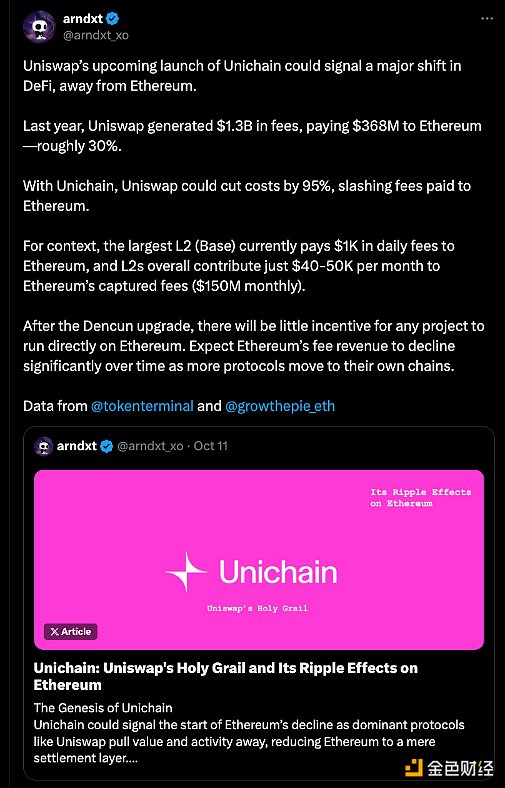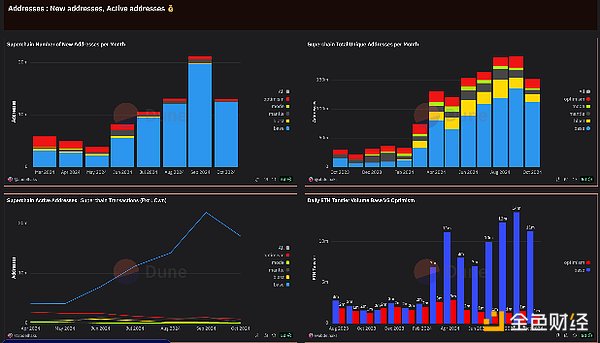Author: arndxt, Threading on the Edge; Translation: Golden Finance xiaozou
I have penetrated the maze of Superchain. My eyes, which were once obscured by the fog, now clearly see through the fog that this network is different from other networks. It is completely different from other chains. It is a flower that blooms from the soil of innovation.

1. The origin and driving force of Superchain
If you are new to this, join me on my journey into Superchain… Let’s explore its origins and the forces that have driven its rise:
(1) Broken L2 ecosystem
Ethereum’s L2 space used to be a constellation of isolated stars — Arbitrum, Polygon, zkSync, etc. — each illuminating its own corner of the universe. Developers were pulled in multiple directions, dispersing resources and diluting network effects. This fragmented ecosystem led to challenges with interoperability, fragmented liquidity, and a steep learning curve for developers to adapt to different protocols.
L2 solutions were developed to enhance Ethereum's scalability by offloading transaction processing work from the main chain. This enabled lower gas fees and higher throughput, effectively increasing the available block space for decentralized applications (DApps). However, the rapid expansion of different L2 solutions has led to fragmentation issues, with applications on separate L2s unable to effectively communicate or share liquidity.
Fragmentation is a barrier to scaling and user adoption, with limited potential for unified growth. Users are confused when switching between platforms, while developers struggle to maintain compatibility between different systems.
(2) The Birth of Optimism Superchain
In this maze, Optimism launched OP Stack, a modular open source framework designed to coordinate these different layers and inject cohesion - Superchain. Superchain's mission is to turn isolated scaling solutions into a unified ecosystem where developers can build seamlessly.
OP Stack modularity supports shared standards and interoperability, greatly reducing development time and creating a collaborative environment. By providing a common foundation, it promotes accelerated innovation and simplifies the cross-platform user experience.
Previously siloed projects on each L2 can now interoperate effortlessly, enabling increased functionality and a larger user base without compromising security or efficiency.
(3) Base
Coinbase launched Base, an L2 network based on OP Stack. With lightning-fast transactions and minimal fees, Base has quickly become a magnet for decentralized applications (dApps) and developers. Its integration with Coinbase's extensive user base provides an entry point for millions of people to enter the Superchain ecosystem.

The rapid adoption of Base highlights the power of combining institutional support with innovative technology. By leveraging Coinbase’s reputation and resources, Base demonstrates how strategic partnerships can accelerate network effects within Superchain.
Popular dApps have migrated to Base to take advantage of its performance and user coverage, resulting in an increase in transaction volume and a surge in active users within Superchain.
(4) Uniswap enters Unichain
Decentralized exchange giant Uniswap recognized the appeal of Superchain and launched Unichain, a rollup specifically designed to serve as a Superchain liquidity center. With a cumulative trading volume of over $1 trillion and a large user base, this move marks a key shift toward ecosystem integration.
Liquidity fragmentation has always been a challenge for DeFi. By integrating liquidity within Superchain, Unichain improves capital efficiency and reduces slippage for traders. This move not only benefits Uniswap, but also strengthens Superchain by centralizing financial activities.

Traders experience increased price stability and reduced transaction costs, while liquidity providers receive better returns due to increased trading activity on Unichain.
(5) Worldcoin launches World Chain to initiate an identity verification revolution
Led by OpenAI CEO Sam Altman, Worldcoin deployed World Chain on Superchain. World Coin aims to verify the identities of millions of unique address users and is the most ambitious Web3 identity verification system to date.
Identity verification is critical for compliance and user trust in decentralized networks. World Chain’s integration provides a scalable solution for proof of personhood, supporting secure, private, and verifiable identities. This advancement enhances the security of dApps and fosters user confidence.
Applications that require identity authentication, such as decentralized finance platforms and voting systems, benefit from seamless integration with World Chain, enhancing user engagement while reducing fraud.
(6) Kraken Ink
Kraken announced the launch of its own L2 solution, Ink, based on the OP Stack. Ink positions itself as a direct competitor to Base, but both benefit Superchain’s rapidly growing influence.
The entry of major exchanges such as Kraken into the L2 space has intensified competition, but it has also helped Superchain’s reliability. Ink aims to leverage Kraken’s extensive user base and industry expertise to drive adoption and innovation within the ecosystem.
Kraken’s integration allows users to easily transition between trading on the exchange and DeFi activities on Ink, enhancing user engagement and liquidity in the ecosystem.
2. The rise of Superchain
Superchain has not only attracted key players, it has become the gravitational center of the Ethereum L2 universe. While Optimism may lag behind Arbitrum and Polygon in terms of TVL, the combined strength of Superchain participants is enough to eclipse the competitors.
Superchian address and activity trends

(1) New address
Base has driven an explosion in new addresses, especially with nearly 20 million new addresses added in September 2024. This trend highlights Base’s role as the main portal for Superchain, likely aided by its user-friendly access and Coinbase’s brand influence.
(2) Unique address
Superchain has over 100 million unique addresses, with Base being the main contributor. This steady upward trend highlights the growing adoption rate and Superchain's success in attracting a diverse and active user base. However, this shows that user growth is dependent on Base, which means that other chains may need to provide unique products or services to have similar appeal.
(3) Active addresses
The number of active users peaked at 20 million in September, mostly on Base. This indicates high daily engagement, positioning Base as the central hub for interaction within Superchain. The relatively low activity of Optimism suggests that most user stickiness is concentrated on Base rather than other Superchain networks.
(4) ETH transfer volume
In terms of daily ETH transfer volume, Base has always been ahead of Optimism, with a peak of 14 million transfers in August. This trend shows that Base is the preferred chain for ETH transactions, probably because Base's lower fees and fast processing speed make it attractive for high-frequency trading.
3. Thoughts on the transformation of Superchain
The story that is unfolding is so thought-provoking and transformative that I believe we are witnessing the beginning of a new era for blockchain technology. Here are my thoughts:
(1) Unified Purpose
Optimism Superchain is a shift from competition to collaboration. Giants like Coinbase, Uniswap, and Kraken have allied under a shared framework, heralding a new era of collaborative innovation.
(2) The victory of network effects
Superchain effectively leverages network effects, creating a feedback loop that amplifies value for all participants. This synergy makes traditional siloed approaches obsolete.
(3) Redefine value alignment
Optimism’s mission of “forking capitalism” resonates deeply. By aligning cross-chain incentives through revenue sharing and open governance, Superchain reimagines how value is created and distributed.
(4) The next wave is coming
Projects like World Chain and Superchain are not just expanding technology, they are using blockchain to expand the human interface. Attracting the next wave of 100 million users is no longer a distant prospect, but a reality that is about to come true.
(5) The future of decentralized finance
Unichain’s liquidity integration solves one of DeFi’s most persistent challenges – fragmentation. Unified liquidity pools can improve efficiency, reduce slippage, and form a more resilient financial ecosystem.
4. Superchain Indicators
To ground this exploration in tangible data, let’s dive into the key indicators pointing to Superchain’s dominance:
●Ecosystem growth rate: Superchain’s development activity increased by 200% year-on-year.
●Interoperability Milestone: The confirmation time of cross-chain transactions within Superchain has been reduced by 30%, greatly enhancing the user experience.
● Economic Alignment: The revenue sharing model has already injected over $50 million into the Optimism network through participating chains, driving further development.
●Enhanced security: The modular OP Stack enables rapid deployment of security upgrades, reducing vulnerabilities by 40% compared to isolated L2 solutions.
●User adoption: The Superchain network achieved a growth of 1 million users in terms of cumulative users in the last quarter alone.
5. Future prospects
All of these developments are happening faster than I expected. We have peeled back layers of complexity and are now at the forefront of a new frontier - a unified, scalable, and inclusive Ethereum ecosystem. Superchain is the renaissance of decentralized technology.
While Superchain is the undeniable leader in L2 scaling solutions today, there is still a long way to go. The blockchain space is constantly evolving, and new innovations will emerge in an endless stream. However, as Superchain's network effect continues to expand, its appeal will make it increasingly difficult for other alternative solutions to divert innovation flow and user adoption.
Optimism's strategic alignment in technology, philosophy and economic incentives is not only setting the pace, it is redefining the game.












